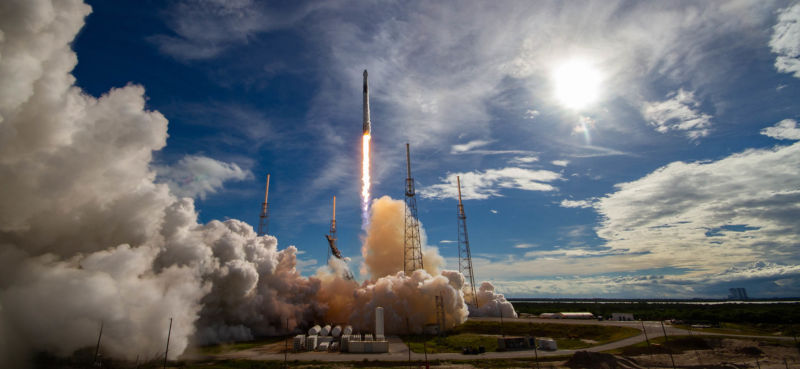
By some measures, SpaceX has had a relatively sedate 2019. After all, the company has launched a mere dozen rockets so far this year, in comparison to a record-setting 2018, with 22 overall missions. It should add one more flight to that tally on Monday, with the launch of a large, 6.8-ton communications satellite from Cape Canaveral Air Force Station (see details below).
However, the lower launch cadence masks a year in which SpaceX has made considerable technical progress toward some of its biggest goals—an optimized Falcon 9, satellite Internet, and total launch reusability.
Falcon 9
SpaceX founder Elon Musk has long talked about rapid, reusable launch, and in 2019 he continued to make strides toward this vision. The Falcon 9 may have flown less in 2019 due to its lightened manifest, but individual boosters flew more.
During a Starlink satellite launch in November, a Falcon 9 first stage flew for the fourth time. That is the first time the same core, and its nine Merlin engines, have flown four missions and suggests that SpaceX will eventually make good on its goal of eventually flying Falcon 9 first stages 10 times before major refurbishment or retirement.
-
A thrice-used Falcon 9 rocket launched into space in November.Trevor Mahlmann
-
Nine Merlin engines all firing at once.Trevor Mahlmann
-
The weather was fine in Florida.Trevor Mahlmann
-
This was the fourth time this rocket's first stage has flown.Trevor Mahlmann for Ars
-
It was a pleasant November morning in Florida.Trevor Mahlmann
-
The Falcon 9 rocket is seen on Sunday, before going vertical at Space Launch Complex 40 in Florida.Trevor Mahlmann for Ars
-
Here's a close-up shot of the payload fairing.Trevor Mahlmann for Ars
-
The stack of 60 Starlink satellites for Monday's flight.SpaceX
-
This first stage has previously flown three times.Trevor Mahlmann for Ars
-
This was the first time SpaceX has flown a first stage four times.Trevor Mahlmann for Ars
SpaceX did abandon its efforts to make the whole of the Falcon 9 reusable—it hopes to solve second stage recovery with its Starship project—but the company did have a major breakthrough with the payload fairings of its boosters this year. The company recovered a fairing for the first time in June, and reused one for the first time in November.
Big things are ahead for the Falcon 9 rocket in 2020, as it is likely to launch its first crewed mission—with Doug Hurley and Bob Behknen inside a Dragon spacecraft bound for the International Space Station.
Starlink
SpaceX also got the jump on its broadband constellation competitors in 2019, with the launch of 120 Starlink Internet satellites over the course of two missions. These flights represented the vanguard of a fleet of more than 10,000 satellites in low-Earth orbit that will provide low-latency connectivity around much of the world and may set the company up to compete with traditional Internet service providers as early as 2020.
The company also stoked controversy among astronomers with its train of satellites, which were clearly visible immediately after launch, and as they raised their orbits. However, SpaceX has recognized those concerns, and company officials have said they will experiment with making the underside of the satellites darker so they are less disruptive to nighttime skies
SpaceX has received the brunt of these criticisms as it is the first of several ventures each planning to launch hundreds to thousands of satellites into low-Earth orbit for broadband Internet service. It remains to be seen whether SpaceX can master the considerable technical challenges of providing seamless Internet from orbit, but the company now has two considerable advantages over its competitors—plenty of operational experience in space from 120 satellites, and a peerless, low-cost, reusable rocket.
It is possible that SpaceX will launch a third batch of 60 Starlink satellites at the very end of this month.
Starship
The company also made considerable progress on developing its interplanetary Starship vehicle in 2019. It flew a six-story-tall prototype, Starhopper, twice, with the second flight rising to 150 meters before touching down at its launch site near Boca Chica Beach.
Musk also unveiled a full-scale Starship prototype in September, which it subsequently lost in November during a pressurization test of the vehicle's fuel tanks.
However, the actual construction of a Starship upper stage for the Super Heavy rocket provided the company, with its iterative design philosophy, invaluable experience. This should serve it well at SpaceX pushes forward with development of Starship prototypes that will be able to make suborbital and then orbital flights—perhaps as early as 2020.
To make this happen the company's engineers had to tackle several huge hurdles in 2019, including finalizing development of, and accelerating production of the Raptor rocket engine that will power both the Starship and Super Heavy vehicles. According to Musk, the company is ready to ship its 17th Raptor engine to McGregor for testing this week.
Monday's launch
Weather conditions appear to be favorable for Monday's launch attempt of the JCSAT-18/Kacific1 commercial satellite from Space Launch Complex 40 in Florida. The launch window opens at 7:10pm ET (00:10 UTC Tuesday), and closes at 8:38pm ET (01:38 UTC). A backup launch window is available on Tuesday, opening at the same time.
This particular first stage of the Falcon 9 rocket has flown twice, in May, 2019, and July, 2019, on supply missions for the International Space Station. SpaceX will attempt to recover the stage after the launch of the heavy, geostationary-orbit-bound satellite on the Of Course I Still Love You droneship in the Atlantic Ocean. The company will also attempt to catch both fairing halves in separate recovery ships.
The webcast below should go live about 15 minutes before the launch attempt.
https://news.google.com/__i/rss/rd/articles/CBMicmh0dHBzOi8vYXJzdGVjaG5pY2EuY29tL3NjaWVuY2UvMjAxOS8xMi9zcGFjZXgtdG8tY2FwLXRyYW5zaXRpb25hbC15ZWFyLXdpdGgtbGF1bmNoLXBvaXNlZC1mb3ItYmlnLXRoaW5ncy1pbi0yMDIwL9IBAA?oc=5
2019-12-16 13:15:00Z
52780497114569
Tidak ada komentar:
Posting Komentar